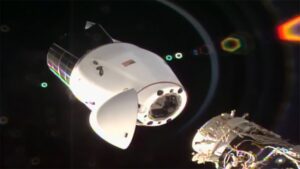Eastern. It had undocked from the station a day and a half earlier after original plans for an undocking and splashdown Jan. 11 were postponed by poor weather.
The Dragon brought back to Earth about 2,000 kilograms of research payloads and other cargo from the station. The spacecraft, launched Dec. 6, brought nearly 3,000 kilograms of cargo to the station, including the Bishop commercial airlock developed by Nanoracks.
The CRS-21 mission was the first to use the new version of the Dragon cargo spacecraft, based on the vehicle SpaceX developed for the commercial crew program. It includes additional cargo volume and on-orbit lifetime, and can dock and undock autonomously, rather than be berthed by the station’s robotic arm.
The new cargo Dragons also splash down off the Florida coast. Original cargo Dragon missions splashed down in the Pacific, southwest of California, and could take a day or more to return to port. On the CRS-21 mission, time-sensitive cargo from the Dragon was transported by helicopter to a lab at the Kennedy Space Center within six hours.
The Dragon is the second cargo spacecraft to depart the station in as many weeks. Northrop Grumman’s NG-14 Cygnus spacecraft left the station Jan. 6, three months after its arrival. That spacecraft remains in orbit performing experiments, including one testing combustion in weightlessness, and will reenter Jan. 26.
“We’ve really hit our stride. This is our new normal,” Robyn Gatens, acting ISS director at NASA Headquarters, said at a Jan. 13 meeting of the NASA Advisory Council’s human exploration and operations committee. “Lots of vehicles coming and going, lots of activity on the station.”
The seven-person crew currently on the station, including four NASA astronauts, is enabling what she called “significant more crew time for what can be dedicated to utilization,” or research activities there. She noted that had long been the goal of the commercial crew program, which enables the station to support seven people rather than the six it could traditionally accommodate when the only means to travel there was via Russia’s three-person Soyuz spacecraft.
NASA has not yet set an end date for the Crew-1 commercial crew mission currently docked there. Gatens said it’s likely to end some time in May, about six months after its launch. It will overlap with the next Crew Dragon mission, Crew-2, whose launch is no earlier than March 30.
That date may slip, though, to accommodate the second uncrewed test flight of Boeing’s CST-100 Starliner spacecraft. That’s scheduled to launch March 29, although Phil McAlister, director of commercial spaceflight at NASA Headquarters, said at the same committee meeting that the Starliner launch could move up a few days to March 25.
The CRS-21 Dragon brought back to Earth a variety of scientific experiments, ranging from heart tissue cells tested on the station to fiber optic cables produced in microgravity. It also brought back a very different commercial payload: 12 bottles of red wine flown to the station in late 2019 by European company Space Cargo Unlimited. The wine, along with 320 snippets of grape vines also flown on the station, will be shipped to a facility in Bordeaux, France, to see how they were affected by their time in space. That will include what the company called a “private, organoleptic wine tasting” to compare the wine flown in space to wine that remained on Earth.



